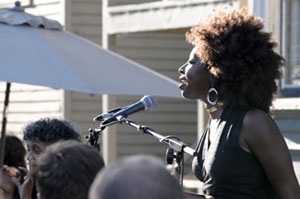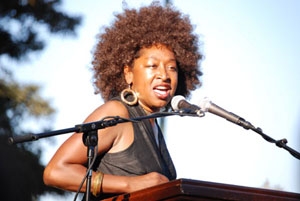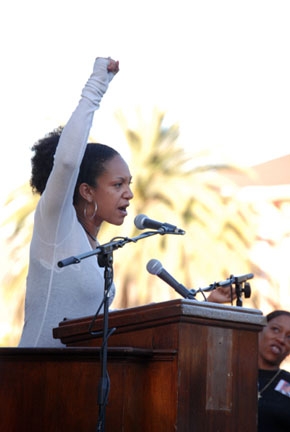Feature: Reviews
Port Huron Project
The Liberation of Our People, a speech by Angela Davis, restaged by Mark Tribe
“We have to show the American people that their sons and their husbands are being victimized by American imperialism. They are being forced to go and fight a dirty war,” said both Angela Davis on November 12, 1969 in DeFremery Park in West Oakland, and an actress portraying her there on August 2, 2008, reenacted as part of artist Mark Tribe’s Port Huron Project 5: The Liberation of Our People.
Davis’s original speech was delivered at a Black Panther rally calling for the release of political prisoners in the US, held two weeks after the trial for the Chicago 7 where Bobby Seale was bound and gagged in the courtroom and sentenced to four years for contempt of court for speaking out of turn. Davis calls for a drawing of parallels between the causes of the Vietnam War and the roots of domestic struggles. At the performance, the suggestion that the anti-war movement may become irrelevant if there is not a shift from a “bring the troops home” stance to a united effort against American imperialism and repression here and abroad evoked applause and cheers of “Right on sister!” from the audience, surreally seeming to arise in spontaneous response to the simultaneous vital importance of the statement in both a historic and contemporary context. At moments the eerie relevancy to our moment was chilling, in her calls to the disparate movements of the left to see their common causes or face failure.
The speech also brought to mind the ways in which the Patriot Act is not anomalous, but is part of a long governmental effort to illegally gather information on citizens, which includes the techniques used by Cointelpro to spy on members of the Black Panther Party.
Previous reenactments of Tribeís Port Huron Project, named after Tom Haydenís 1962 New Left manifesto, include speeches by Paul Potter at The National Mall, Washington, D.C., Howard Zinn on Boston Common, and Coretta Scott King in Central Park. All Port Huron performances are staged at the site of the delivery of the original speech, but Port Huron 5 was recorded at arguably the most charged location thus far. There is a common refrain in contemporary art discussion lately about the efforts to re-animate public space, but in fact DeFremery Park, also known as Little Bobby Hutton Park in memory of a young member of the Black Panther Party killed by an Oakland police officer in 1968, has continuously been a vital family gathering place for the mainly African-American working class neighborhood since its days as the site of many Black Panther Party rallies. Given that within two weeks of this event, four shooting incidents occurred in Oakland involving an Oakland police officer ñ the latest six blocks from DeFremery Park ñ a Black Panther speech at this moment and place seemed both resonant and anachronistic.
There is a recent trend towards work based on reenactments, whether of political speeches, fluxus or music performances or lectures. Perhaps in a time marked by revisionist and disregarded histories and anxiety regarding the future, itís reassuring to acknowledge this moment as part of a greater historical trajectory. In a panel discussion at the Oakland Museum the night before the reenactment, there was mention of Tribe’s piece as an attempt to raise ghosts. This metaphor suggests the risks this work takes in implying that the speakers (many of whom are still alive and working) and their words are powerless or inaccessible until revived within the context of a work of art. This type of nostalgia is in effect a reification of the terms of this specific historical moment, a fact reinforced by the spectacle of the repetition of the speech and its recording for future presentation online and as video installation. By folding this speech into the Port Huron Project, Tribe simultaneously compacts the speech by objectifying it and amputating it from the original radical conversation as well as from a contemporary local context, but also expands and rearticulates its sociopolitical potential by inspiring new conversations and other cultural work around the notion of the historic, political agency and the currency of mythologized historical moments.
The Liberation of Our People is the fifth in Tribeís Port Huron series of reenactments of protest speeches from the New Left movements of the 1960s and í70s, produced in conjunction with Creative Time of New York and the Oakland Museum of California. Creative Time has commissioned three new pieces by Tribe as part of their national series of public art projects, Democracy in America, curated by Nato Thompson. We Are Also Responsible, based on a 1971 speech by César Chávez, was performed and recorded on July 19, 2008 in Exposition Park, Los Angeles and Let Another World Be Born, based on a 1967 speech by Stokely Carmichael, will be performed on September 7, 2008 near the United Nations in New York. The Liberation of Our People was performed twice ñ once by Alita Hayes and once by Sheila Brooks ñ to a live audience and videotaped by multiple cameras for later presentation in multiple environments: online, in gallery installation and on a large-scale HD screen in Times Square.
Midway through the second delivery of the speech, amid two family reunions, a wedding party, and a gathering of art patrons, one of the family members broke away from his reunion and circled the crowd in front of the podium and shouted, “What about now?!” Tribe later joked that the disrupter might have actually suggested an apt title for this or a future project. Not a bad idea.
(Angela Davis and other speakers at the Nov 12, 1969 rally (including Terence Hallinan) can be heard here.)



